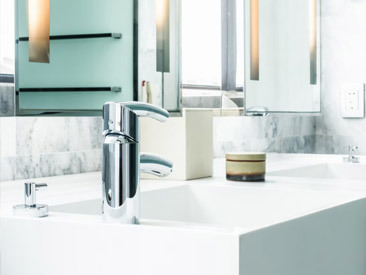The Ultimate Guide to Stylish Kitchen Sinks: Choosing the Perfect Fit for Your Culinary Space
2024-09-28
Author:
The Ultimate Guide to Stylish Kitchen Sinks Table of Contents Introduction to Stylish Kitchen Sinks 1. The Importance of Choosing the Right Kitchen Sink 2. Types of Kitchen Sinks: An Overview 2.1 Undermount Sinks 2.2 Top-Mount Sinks 2.3 Farmhouse Sinks 2.4 Apron-Front Sinks 2.5 Double and Single Basin Sinks 3. Materials Use

The Ultimate Guide to Stylish Kitchen Sinks
Table of Contents
- Introduction to Stylish Kitchen Sinks
- 1. The Importance of Choosing the Right Kitchen Sink
- 2. Types of Kitchen Sinks: An Overview
- 2.1 Undermount Sinks
- 2.2 Top-Mount Sinks
- 2.3 Farmhouse Sinks
- 2.4 Apron-Front Sinks
- 2.5 Double and Single Basin Sinks
- 3. Materials Used in Stylish Kitchen Sinks
- 3.1 Stainless Steel
- 3.2 Porcelain
- 3.3 Composite
- 3.4 Cast Iron
- 3.5 Stone Sinks
- 4. Design Trends in Kitchen Sinks
- 4.1 Color Trends: Beyond the Traditional
- 4.2 Sleek and Minimalist Designs
- 4.3 Vintage and Retro Styles
- 5. Installation Options and Tips for Kitchen Sinks
- 6. Maintenance and Care for Kitchen Sinks
- 7. Budgeting for Your Kitchen Sink
- 8. Frequently Asked Questions about Kitchen Sinks
- Conclusion
Introduction to Stylish Kitchen Sinks
The kitchen is often regarded as the heart of the home, and a stylish kitchen sink can significantly enhance its appeal. A well-chosen sink marries functionality with aesthetic value, making it a crucial element of kitchen design. In this guide, we will cover everything you need to know about stylish kitchen sinks, including types, materials, and design trends, helping you make an informed choice for your culinary space.
1. The Importance of Choosing the Right Kitchen Sink
Selecting the right kitchen sink goes beyond just functionality. A sink can serve as a focal point in your kitchen and can dictate the overall design theme. The right sink will not only complement your kitchen's style but also enhance your cooking experience, making tasks like washing dishes and meal preparation more efficient and enjoyable.
2. Types of Kitchen Sinks: An Overview
Understanding the different types of kitchen sinks available will help you make an informed choice that suits your needs and style preferences.
2.1 Undermount Sinks
Undermount sinks offer a seamless look as they are installed beneath the countertop. This design minimizes the visual clutter around the sink area and makes cleaning easier. They work beautifully with solid surface countertops like granite or quartz.
2.2 Top-Mount Sinks
Top-mount sinks, also known as drop-in sinks, are easy to install. They sit on top of the countertop, with the rim resting on the surface. This type is often more budget-friendly and provides a classic look for various kitchen styles.
2.3 Farmhouse Sinks
Also known as apron-front sinks, these sinks extend beyond the cabinetry, offering a vintage charm. Their deep basins allow for easier washing of large pots and pans, making them a favorite among home cooks.
2.4 Apron-Front Sinks
Similar to farmhouse sinks, apron-front sinks feature a distinct front that adds character to your kitchen. They are available in various materials and styles, allowing for versatility in design.
2.5 Double and Single Basin Sinks
Double basin sinks provide the advantage of multitasking; you can wash dishes in one side while rinsing in the other. Single basin sinks, on the other hand, offer more space for larger items. Your choice depends on personal preference and how you use your kitchen sink.
3. Materials Used in Stylish Kitchen Sinks
The material of your kitchen sink affects its durability, maintenance, and aesthetics.
3.1 Stainless Steel
Stainless steel is a popular choice due to its durability and modern appeal. It resists rust, stains, and heat, making it an ideal material for busy kitchens.
3.2 Porcelain
Porcelain sinks add a classic touch with their smooth, glossy finish. They are easy to clean but can chip or scratch if not handled carefully.
3.3 Composite
Composite sinks are made from a blend of materials like acrylic and granite. They offer a wide range of colors and textures and are resistant to scratching and staining.
3.4 Cast Iron
Cast iron sinks are incredibly durable and often coated with enamel for easy cleaning. They come in various colors, adding a touch of personality to your kitchen.
3.5 Stone Sinks
Stone sinks, such as those made from granite or marble, provide a luxurious aesthetic. While they require more maintenance, their beauty can be unmatched.
4. Design Trends in Kitchen Sinks
Kitchen sink design trends evolve, reflecting changing tastes and styles. Here are some popular trends to consider:
4.1 Color Trends: Beyond the Traditional
While stainless steel and white sinks are classic options, colored sinks are gaining popularity. Shades like matte black, navy blue, and earthy tones can create a stunning focal point in your kitchen.
4.2 Sleek and Minimalist Designs
Minimalist sinks with clean lines and simple shapes are trending, aligning with modern kitchen aesthetics. These designs often feature integrated draining boards or sleek faucets.
4.3 Vintage and Retro Styles
Vintage-inspired sinks are making a comeback, often featuring intricate details and charming designs that add character to contemporary kitchens.
5. Installation Options and Tips for Kitchen Sinks
Installing a kitchen sink can be a straightforward process, but there are several factors to consider. Ensure proper plumbing connections, and consider hiring a professional if you are not experienced. Assess the countertop compatibility, as some sink types require specific installation techniques.
6. Maintenance and Care for Kitchen Sinks
To keep your kitchen sink looking stylish and new, regular maintenance is crucial. For stainless steel sinks, use a soft cloth and mild cleaner to prevent scratches. Porcelain and composite sinks may require specialized cleaners to avoid damage. Always rinse and dry your sink after use to prevent buildup.
7. Budgeting for Your Kitchen Sink
When budgeting for your kitchen sink, consider the cost of the sink itself, installation fees, and any additional accessories, such as faucets and soap dispensers. Prices can vary significantly based on material, size, and brand, so research thoroughly to find the best option for your budget.
8. Frequently Asked Questions about Kitchen Sinks
What is the best material for a kitchen sink?
The best material depends on your needs. Stainless steel is durable and resistant to stains, while porcelain offers a classic aesthetic.
How do I maintain my kitchen sink?
Regular cleaning with appropriate cleaners and avoiding harsh abrasives can help maintain your sink's appearance.
Can I install a kitchen sink myself?
If you have plumbing experience, it is possible. However, hiring a professional is advised for the best results.
What size kitchen sink should I choose?
The size should be determined by your kitchen layout and your cooking habits. Consider how much space you have and the tasks you perform.
Are farmhouse sinks practical for everyday use?
Yes, farmhouse sinks are practical due to their deep basins, which allow for washing larger items easily.
Conclusion
Choosing the right stylish kitchen sink is a pivotal decision that impacts both the functionality and aesthetic of your kitchen. By understanding the types, materials, and trends available, you can select a sink that perfectly meets your needs while enhancing your culinary space. With proper maintenance and care, your kitchen sink can be a beautiful and enduring centerpiece for years to come.









